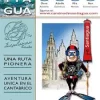Been there, proposed that, three years ago. I can still see the incredulous looks of office staff and management and the shrieks of laughter that followed. Surely you can't be serious...? This alternated with statement akin to 'that is just NOT the way things are done..."
Two reasons given... I had to distill these answers from a wider range of comments at the time.
1.
Most pilgrims would not understand they had to do something to validate their credencials along the way, would not do it, then would riot at the office when told they were not eligible for a Compostela because they did not follow instructions...
To credit this, we are talking about a LOT of folks from latin cultures, they are not famous for following instructions, feelings and intuition count a lot. For that matter, neither am I (keen about instructions), and I am 67% Italian by ancestry... just sayin...
We are also talking about a lot of pilgrims from countries where the native language does not even use Roman letters and Arabic numbers... not to mention that the most often used credencial is printed in Spanish... Thinking about these baked-in issues and challenges, you begin to understand the scope of the problem of simply throwing automation at the problem..
2.
Too complicated. Ironically, the part that agitated staff the most was the incorrect notion that rapidly producing laser printed certificates of any kind would somehow equate to loss of jobs. This is a VERY sore subject in Spain, with a chronically high unemployment rate. No one wanted to hear about a perfect calligraphic font producing uniformly beautiful printed certificates, every time. No one really understood the impact of having double the current number of arrivals every day, for all of 2021, and then an elevated number beyond that. A few of the staff understood the need to introduce SOME automation to assist the process...
Yet, to my knowledge and understanding, no one there actually understands the concept of process reengineering. No one is looking at the entire issue. No one has gotten a blackboard, whiteboard, or large sheet of paper and diagrammed out the problem and the incoming 'client' flows, and what needs to be done to address them. Similarly, no one has given thought to the overall problem of 600,000 - 650,000 pilgrims, plus the 'solo sello' folks descending on the current process and resources during 2021.
I need to make clear that NO ONE, including me, knows the true likely number of pilgrims or simply folks desiring some sort of certificate will show up in 2021. But evaluation of prior Holy Years suggests an approximate 50% INCREASE from the last preceding normal or base year.
Before I left this year's volunteer stint in Santiago, earlier this past week, I DID manage to have a "driveby" conversation with a senior management official from the Cathedral hierarchy. This person works in the administration of things pilgrim-related, including business oversight of the Pilgrim Office.
I managed to run some process ideas by this manager, including the high-level notion that the daily incoming pilgrim flows had to be triaged, and the portioned-off sub-groups directed to a process designed to address the sub-group needs as efficiently as possible.
My 'off-the-cuff' sub-group processes were focused on developing and testing processes and dedicated staff, physical plant, and necessary resources to handle:
- individual pilgrims choosing to file their data in advance, via an app, and automation for express processing away from the main process flow;
- single pilgrims seeking to not choose the fast and highly efficient automated express system, do things the 'old-fashioned' way (aka, the current FIFO method) and obtain handwritten Compostelas, etc.;
- groups of more than 10 persons (mandatory pre-registration and automation - NO "SURPRISE, here we are... arrivals); and
- small groups and family groups (< 10 persons).
Bear in mind, I used to do this sort of process engineering during my professional career.
It remains to be seen whether and of these seeds will fall on fertile ground. I was asked point blank if I was available to consult and I immediately responded yes, I would be honored to help in any way I could. Details TBD... We shall see. But, I will no hold my breath.
BTW, my "be-all, end-all" foolproof system relied on locked-on Fit Bit like wristbands with anti-tampering features like retail tags. You must have one of these fitted at an approved starting place, like a pilgrim office or tourism office at onlyapprived locations, and pay a REFUNDABLE DEPOSIT of - say €10. A removed or tampered with band, signals this tampering and marks the user file as compromised.
Along the paths, every km or so, one mojone will have been supplemented by a solar powered RFID sensor and signal pinger. As you walk or cycle along, doing nothing except keeping that wristband on, the mojone pings your bracelet and updates the database with your precise location, . When you make the final approach to the pilgrim office,m the system uploads your data file to a pending file (date, time, location, etc.) Computer code could pre-assess the data to determine if you cheated or not.
On arrival, a staff persons merely confirms your identity, what certificates you are eligible for, and selects them from a menu to laser print. Easy-peasy... but very scary to a lot of people...
END NOTE:
This all said, the more recently developed notion of "just stop issuing Compostelas or other certificates," in favor of just affixing sellos to a credencial starts to look better all the time.
My PERSONAL view is that, if you are not going to do it properly to best serve your clients, you ought not do it at all...
Make no mistake about it, each and every pilgrim who makes the effort to comply with the rules and who shows up at the Pilgrim Office seeking some sort of evidence of completion of this accomplishment is a client. They deserve to be treated in a professional, sober manner, commensurate with the accomplishment they have finished.
Hope this helps... Jet lag sucks by the way...
























